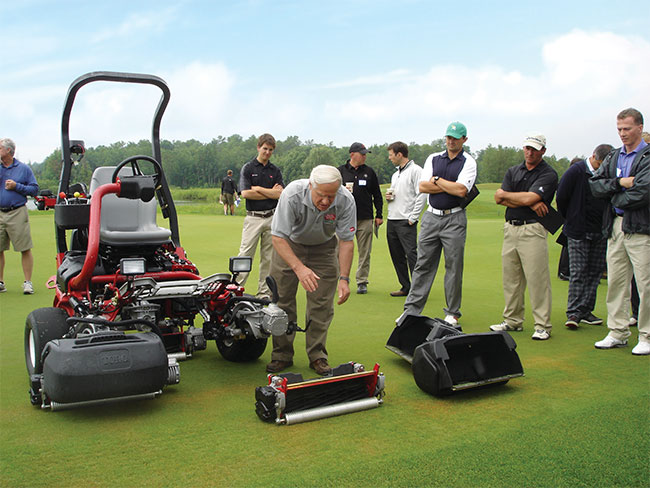
Features
Golf
Check your attitude
Improper reel selection, improper bedknife selection and improper reel attitude setup lead to inefficient cutting.
February 25, 2020 By Mike Slack
 The rule of thumb in reel selection is, the lower the height, the more blades are required.
The rule of thumb in reel selection is, the lower the height, the more blades are required. Good day, turf people. My name is Mike Slack. I have owned and operated Slack Reel Service Inc. in Burlington, Ont. for the past 30 years.
Turf & Rec has requested that I write a periodic article on reel mowers – in particular the common issues that golf and turf technicians face on a regular basis. My company services several golf courses throughout Ontario, and one of the most common issues I come across is that technicians cannot get their mowers to cut as efficiently as required. Problems such as choppy or serrated cuts, scalping issues and comments like “It looks like it ain’t cutting but there is grass in the bucket!” are common.
I would like to share my thoughts on the most common reasons for this that I see in my travels. Before I do, I would like to mention that our industry has had a shortage of technicians in previous years, not unlike most trades today.
We are seeing other mechanical industries, such as auto, filtering into the turf field. Some of these people are great at diagnosing issues with the mechanics of the unit, but have never worked on reels before in their career. Reel training is extremely limited in our industry and most often comes down to a “who you know” way of business. Some OEM manufacturers offer one or two-day seminars for mechanics that are a start, but it has always been easier to have someone deal with your specific issues at your specific turf property.
The three most common reasons for mowers not cutting as efficiently as possible are improper reel selection, improper bedknife selection and improper reel attitude setup.
Improper reel selection
Reels vary in several ways but one difference is their number of blades. Reels can have five, seven, eight, 11, 14 or 15 blades. There is a good reason for this. It is referred to as the “clip rate.” Clip rate is defined as the forward distance travelled between successive blade contacts at one shear-point.
If you have too many blades for your height of cut, it is extremely possible that as the reel cuts, the grass blades do not have enough time to stand up between each blade, resulting in grass blades being missed and giving a shaggy cut.
If you have too few blades, it is entirely possible to end up with a serrated cut or a “choppy look” cut.
Rule of thumb: the lower the height, the more blades required.
Another factor that contributes to cut quality is ground speed. Your operator might come in and say, “I just cut 18 fairways in 45 minutes! I deserve a medal.” If he is driving the unit as if he has been entered in the Daytona 500, there will be a great chance of poor quality of cut.
Bedknife selection
A bedknife provides the second edge in the shearing action of the reel. Selection of the proper bedknife is crucial for the height of cut you are attempting to attain.
Rule of thumb: The lower you go in height of cut, the thinner the bedknife needs to be.
It is important to select a bedknife that best suits your height of cut and one that is not too thin for the job. Otherwise, it will result in having to replace the bedknife more often.
Most bedknife manufactures will provide a bedknife guide to assist you in finding the proper bedknife for your required height of cut, but this does not normally take into consideration reels that are worn, which leads me to “reel attitude.”
Reel attitude
Real attitude is the relationship between the bedknife angle to the cutting surface. This can be set aggressively for a crisper, cleaner cut. A negative attitude can be detrimental to any “quality of cut.” I usually explain “attitude” to technicians this way: picture a pile of dirt and grass on your shop floor because your operator does not truly understand the meaning of “cleaning the machine” after use. Try to pick up the dirt and grass clippings by laying a shovel flat on the ground. With the same dirt and grass clippings and shovel, try it again but now tip the shovel on a 20-degree angle while scooping up the pile. The shovel tipped to 20 degrees provides a more aggressive angle and should pick up more off the floor. This is the same idea with bedknives and turf.
Roller maintenance
Always ensure your rollers are in good working shape. A faulty roller will affect your quality of cut. Rollers may require a change in bearings or seals after prolonged use. Always remember to keep your rollers greased if necessary. Reels and rollers should be inspected prior to each use.
I hope these tips are of help to your turf technician. As vast as the turf industry is, we are a very tight-knit group, and I’m sure a fellow tradesman or at the very least, myself, can get you on your way to excellent mower setup, resulting in great turf conditions.
Please send your comments on this article or any problem ideas you may be having, and we will do our best to address them in future articles.
Mike Slack is the owner of Slack Reel Services, which has been serving the golf and turf industry since 1989. The business is family run and deals with various companies across Ontario and other parts of Canada, specializing in reel mower sharpening, parts distribution and on-road service technical work, mainly in Ontario. The business may be reached by calling (905) 516-4757 or by emailing slackreelservice@gmail.com.
Print this page